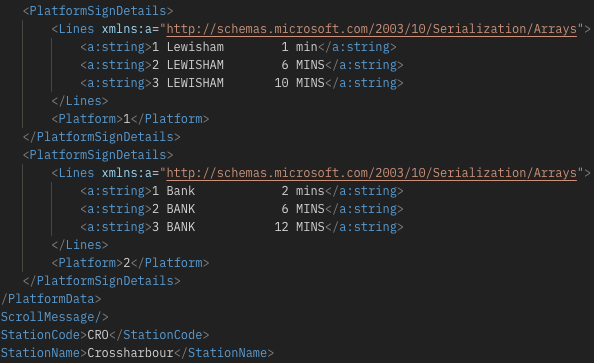Are vehicles with no destinationName and no direction not in service?
thank you i will have a look
In the metropolitan thread it is disscussed that vehicleId is not actually the id assigned to that physical train service, is there any identifier that is? like is just plain id the actual identifier for the vehicle?
No, there isn’t any unique identifier for the vehicle and it’s a bit of a sore point. The train ID is related to timetable codes and it’s not uncommon to have multiple identical identifiers on the line at once. Plus there’s the ‘000’ problem which is common on some lines. In the underlying ‘Trackernet’ data there are identifiers that should be unique - LCID and Leading Car ID (which you would think would be the same thing, but they’re not) but these are often blank. Trackernet has its own ID for each train, or rather it has two (sometimes) but they seem to change without warning. All in all it’s a bit messy. The worst by far is the DLR which has no identifiers at all.
Do we know if there is any plans to get LCID or TrainID into the unified API, also I’ve seen a fair few post about Trackernet as a legacy system but I can’t seem to find any documentation on it more recent than 2010, is it still in use and if so do you have any links I can have a look at so I could perhaps learn to use that instead?
Does anyone know what the lines are called in Trackernet for dlr, overground, Elizabeth and trams?
Thanks ![]()
So just found out the underlying system for DLR is daisy and not tracker net, so i cant use LCID or TrainID for dlr, what if known are the underlying systems for as mentioned before overground, Elizabeth and trams and do they have anything akin to LCID or TrainID ?
@fraser I can tell you that if you want to use the National Rail based services (Overground and Liz Line) then there are way of tracking the same vehicle being using in the NRE Darwin data.
The data contains an optional section in locations->location called “association”. This can category of “divide” or “join” (for a train that does that, for example SouthEastern, Southern and GWT).
However there is also the often-seen (on the last stop) of “next” where the next RID of next service done by the same train is provided. This includes trips to and from the depot if this happens to a peak service.
Here’s a currently running Liz Line 202310247679837 showing the daisy chain link to 202310247678888
Ah I see, thank you, so simply using darwin would work for overground and liz. So the only mode with no way to identify services through an id is the dlr then ?
Hi @fraser
Unfortunately we don’t get DLR vehicle IDs from the source data.
This only includes the departure board data that is the same that powers the dot matrix screens at DLR stations like below:

Thanks,
James
Hi James, I thought as much, thanks for the comfirmation ![]()
Though looking at that source data, do platforms or stations only ever get three predictions or will they get more than that any time?
When I was looking at it, it seems a possible assumption that there are never more than one DLR train between each station. Using a Graph of the DLR with this information, it seemed possible to work out how many trains were between each station by using the “time to station” and using the platform and links as “places where trains can be”.
From this I had some code that seemed to be able to pick out the trains and give them ids.
However, sometimes the DLR runs in non-standard ways, such as engineering works or Comicon at the Excel Centre. I don’t have a store of the data from these events so it’s possible my assumptions may be in error.
@briantist Yeah I was thinking of experimenting with a similar approach, I feel I can solve if even if its not perfect in those certain event cases, thanks for the reply ![]()
